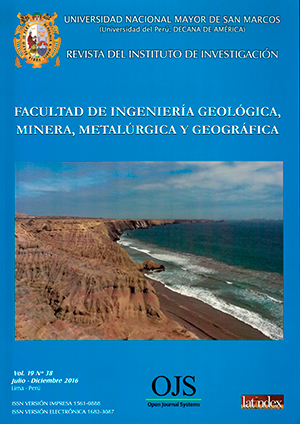Evaluation of the Ulva lactuca macroalgae like an aportant of nutrients to a methanogenic inoculum in the production of biogas and biol throught anaerobic digestion of organic wastes of the UNALM restaurant
DOI:
https://doi.org/10.15381/iigeo.v19i38.13582Keywords:
Anaerobic digestion, potential biochemical methane, Ulva lactuca, organic liquid fertilizerAbstract
The present research aimed to evaluating the performance of Ulva lactuca in biogas production and biol, analyzing their interaction with cow rumen contents, for which organic waste from dining hall UNALM was used as substrate for the batch test potential biochemical methane (PBM) at laboratory scale. This pretreatment of the inoculum was performed, consisted in the incubation of Ulva lactuca to 20%, 30%, 50% and 100% and rumen contents for 15 days, then the test for determining methanogenic activity (SMA) for all samples and finally choose the best treatment characteristics of methane generation. The sample of 100% Ulva lactuca content and rumen contents obtained the best terms to use as inoculum in the PBM test where the volume of biogas was determined and biol quality was evaluated. The results showed that during the first 5 days the more methane is generated, the following days there were constant but lower than the first day production test finally ended after 17 days where methane production stopped. There was an average of 68% methane content. The production of methane from organic waste dining was 1.3 L CH4/g VS added and methane production from the inoculum without substrate was 0.1 L CH4/g VS. The bioles were subjected to an analysis of physico-chemical parameters such as pH, electrical conductivity, organic matter concentration, C, N, P, K, Ca, Mg, Na, heavy metals (Pb, Cd, Cr) and microbiological as much of total coliforms, fecal coliforms. Furthermore, the effects were evaluated on germination and growth of lettuce seeds in a trial of acute toxicity. Laboratory results showed that the Biol had aldedor pH 5, an acid value from the theoretical value that should be in a methanogenic stage (6.8-7.8). Nutrient concentrations also increased significantly. Similarly, heavy metals concentrations increased, however not the limits set out in international standards exceed. Pathogen load was below the standard for quality of water for irrigation, ie can be considered as the Biol a safe product for use as organic fertilizer. Finally, the phytotoxicity test showed that concentrations of 1%, 0.1 and 0.01% are close to the optimal dosage in the use of Biol.
Downloads
Published
Issue
Section
License
Copyright (c) 2016 Melissa Capcha E., Lawrence Quipuzco U., Víctor Meza C.

This work is licensed under a Creative Commons Attribution-NonCommercial-ShareAlike 4.0 International License.
AUTHORS RETAIN THEIR RIGHTS:
a. Authors retain their trade mark rights and patent, and also on any process or procedure described in the article.
b. Authors retain their right to share, copy, distribute, perform and publicly communicate their article (eg, to place their article in an institutional repository or publish it in a book), with an acknowledgment of its initial publication in the Rev. Inst. investig. Fac. minas metal cienc. geogr.
c. Authors retain theirs right to make a subsequent publication of their work, to use the article or any part thereof (eg a compilation of his papers, lecture notes, thesis, or a book), always indicating the source of publication (the originator of the work, journal, volume, number and date).























